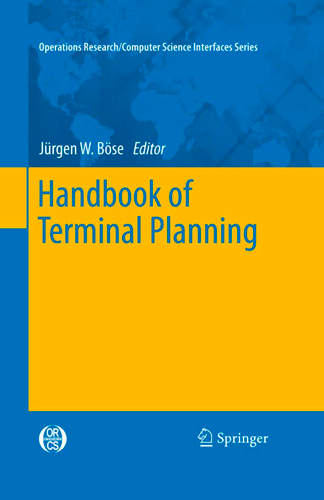Handbook of Terminal Planning/Руководство по планированию терминалов
Книга на английском языке
Container Terminals (CT) operate as central nodes in worldwide hub-and-spoke networks and link ocean-going vessels with smaller feeder vessels as well as with inbound and outbound hinterland transportation systems using road, rail, or inland waterways. The volume of transcontinental container flows has gained appreciably over the last five decades -- throughput figures of CT reached new records, frequently with double-digit annual growth rates. Stimulated by throughput requirements and stronger competition between terminals settled in the same region or serving a similar hinterland, respectively, cost efficiency and throughput capabilities become more and more important. Nowadays, both terminal capacity and costs have to be regarded as key indicators for CT competitiveness. In respect of this steady growth, this handbook focuses on planning activities being aimed at “order of magnitude improvements” in terminal performance and economic viability. On the one hand the book is intended to provide readership with technological and organizational CT basics for strategic planning. On the other hand this book offers methodical assistance for fundamental dimensioning of CT in terms of 'technique', 'organization' or 'man'. The former primarily considers comprehensive information about container handling technologies representing the state of the art for present terminal operations, while the latter refers to methodological support comprising in particular quantitative solutions and modeling techniques for strategic terminal decisions as well as straightforward design guidelines. The handbook includes an introductory contribution which gives an overview of strategic planning problems at CT and introduces the contributions of the volume with regard to their relationship in this field. Moreover, each paper contains a section or paragraph that describes the impact of findings investigated by the author(s) for problem-solving in long-term planning of CT (as an application domain). The handbook intends to provide solutions and insights that are valuable for both practitioners in industry who need effective planning approaches to overcome problems and weaknesses in terminal design/development and researchers who would like to inform themselves about the state of the art in methodology of strategic terminal planning or be inspired by new ideas. That is to say, the handbook is addressed to terminal planners in practice as well as to students of maritime courses of study and (application oriented) researchers in the maritime field.
Contents
Dedication
Preface
Introduction
Contributors
1 The Marine Environment and its Effects on Port Design and Construction
1.1 Introduction
1.2 Water-level Variations
1.3 Weather Factors
1.4 Wind
1.5 Currents
1.6 Waves
1.7 Ice
References
2 Port (harbor) Elements: Design Principles and Considerations
2.1 General
2.2 Ships and their Influence on Port Design
2.3 Access (Navigation) Channel
2.4 Port (Harbor) Entrance
2.5 Port Water Area (Harbor)
2.6 Location, Orientation, Size, and Shape of the Port
2.7 Quay Basin
2.8 Offshore Installations
2.9 Port-Related Marine Structures
2.10 Structural Materials
2.11 Breakwaters
2.12 In-Harbor Slope Protection
2.13 Aids to Navigation
2.14 Mooring Accessories
2.15 Fender Systems
3 Design Loads
3.1 General
3.2 Environmental Loads
3.3 Mooring Loads
3.4 Loads From Cargo Handling and Hauling Equipment and Uniform Distributed Loads
3.5 Ship Impact (by M. Shiono in collaboration with G. Tsinker)
3.6 Ice Loads
3.7 Seismic Loads (by W. S. Dunbar)
3.8 Load Combinations
References
4 Geotechnical Aspects of Soil-Structure Interaction Design Considerations
4.1 General
4.2 Subsurface Investigation
4.3 Soil Liquefaction and Evaluation of Liquefaction Potential (by G. Tsinker and W. S. Dunbar)
4.4 Basic Design and Construction Considerations
4.5 Soils and Bedrock
4.6 Properties and Characteristics of Soils
4.7 Lateral Soil Pressure
4.8 Friction Forces on Walls
4.9 Dynamic Soil Pressures
References
5 Gravity-type Quay Walls
5.1 General
5.2 Basic Structural Arrangements
5.3 Basic Design Considerations
5.4 Design of Blockwork Quay Walls
5.5 Design of Quay Walls Comprised of Floated-in Concrete Caissons
5.6 Design of Quay Walls Composed of Large-Diameter Cylinders
5.7 Design of L-Shaped Walls
5.8 Design of Cellular-type Steel Sheet-pile Bulkheads
5.9 Design of Cribwork-type Quay Walls
5.10 Reinforced Earth Quay (by D. Weinreb and P. Wu)
6 Sheet-Pile Bulkheads
6.1 Introduction
6.2 Sheet-Piling—Structural and Driving Aspects
6.3 Anchor Systems
6.4 Wall Capping
6.5 Construction Methods
6.6 Earth Pressures on Flexible Walls: State-of-the-Art Review
6.7 Design of Sheet-pile Walls
6.8 Sheet-Pile Bulkheads Built on Creep Soils
6.9 Anchorage Design
6.10 Waling and Tie-Rod Design
6.11 Ground (Rock) Anchors
6.12 Overall Stability
6.13 Seismic Design of Anchored Sheet-Pile Walls (by W. S. Dunbar)
6.14 Sheet-Pile Wall Failure
References
7 Piled Waterfront Structures
7.1 Introduction
7.2 General
7.3 Open Pile Structures With Suspended Decks
7.4 Relieving Platforms
7.5 Structural Elements
7.6 Pile-Soil Interaction
7.7 Laterally Loaded Piles
7.8 Piled Marine Structures Design Methods
References
8 Offshore Deep Water Terminals
8.2 Layout
8.3 Mooring System
8.4 Dolphins and Platforms
8.5 Structural Design
References
9 Modernization of Existing Marine Facilities
9.1 Introduction
9.2 Modernization of Mooring Structures
9.3 Modernization of Waterfront Structures: Characteristic Examples
References
10 Breakwater Design (by S. Takahashi)
10.1 Historic Development of Breakwaters
10.2 Design of Conventional Vertical Breakwaters
10.3 Design of New Types of Vertical Breakwater
10.4 Design of Horizontally Composite Breakwaters
10.5 Design of Rubble-Mound Breakwaters
References
Index




